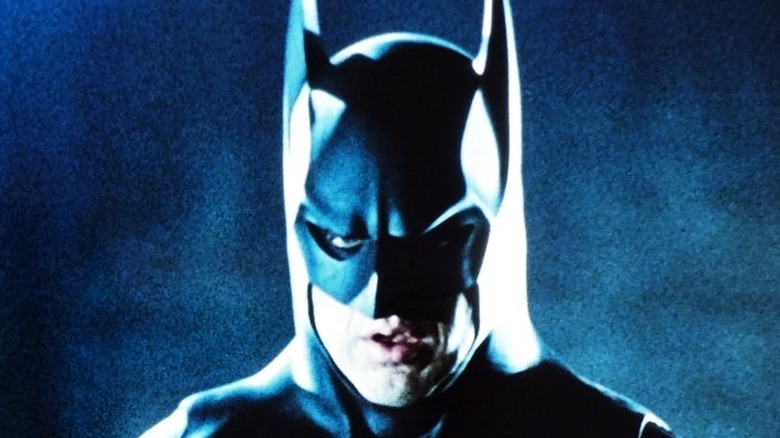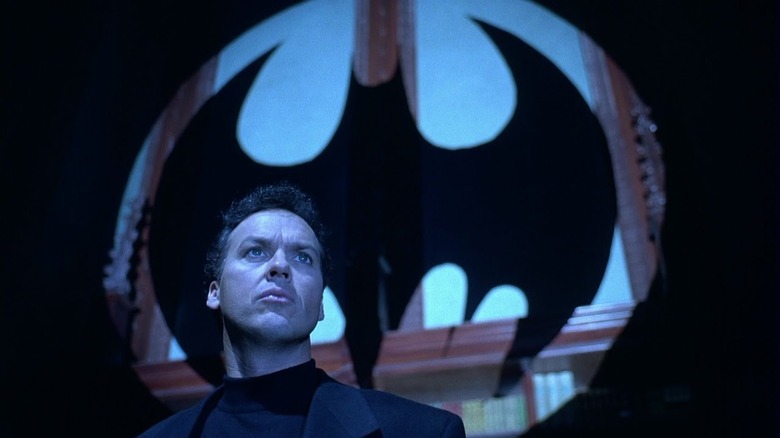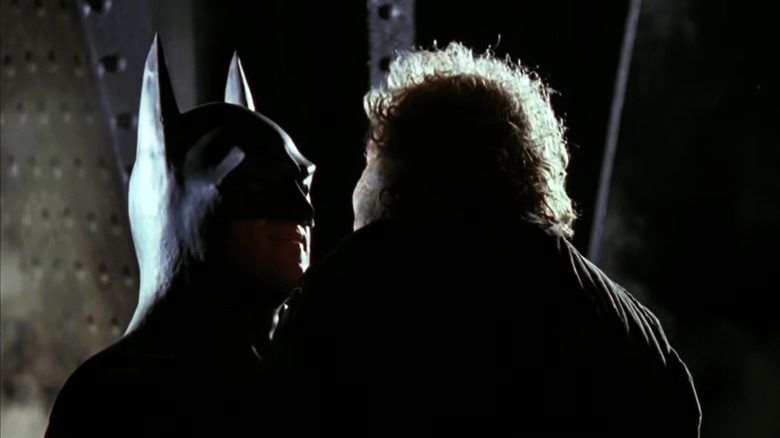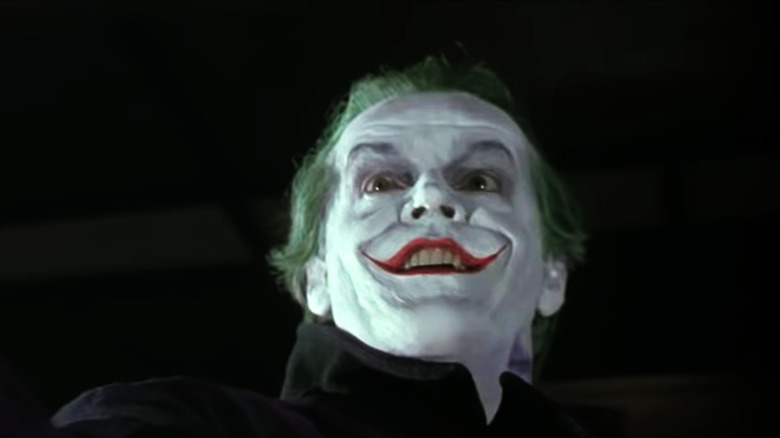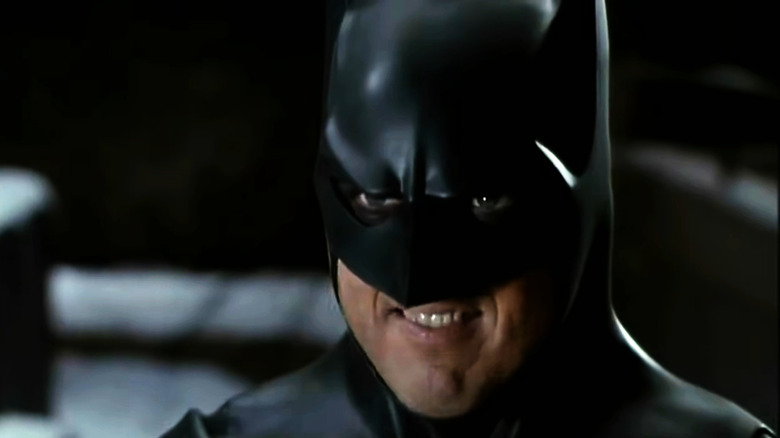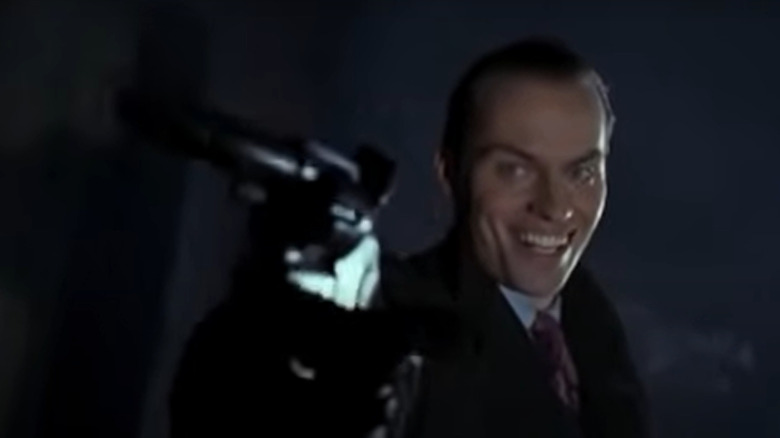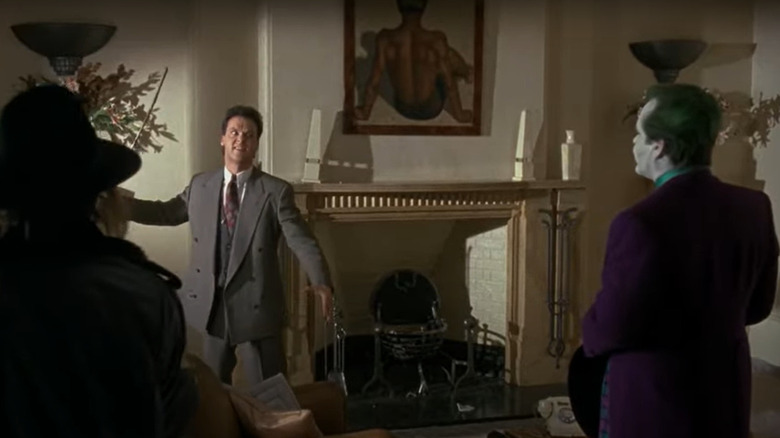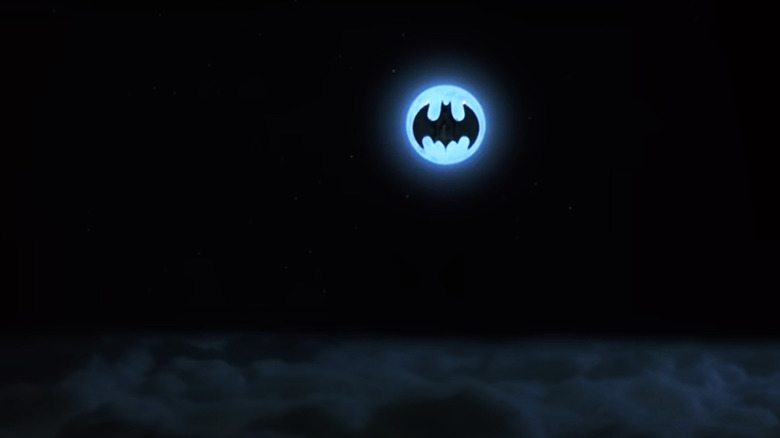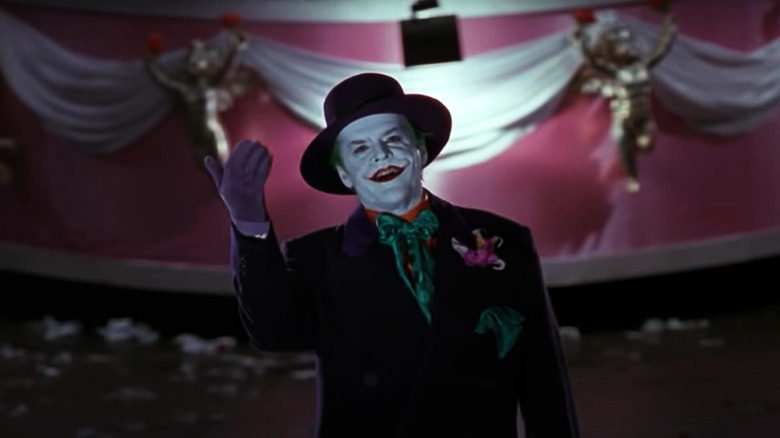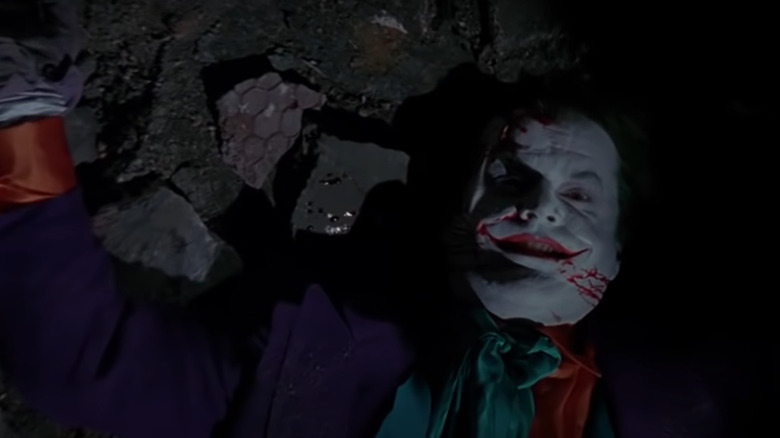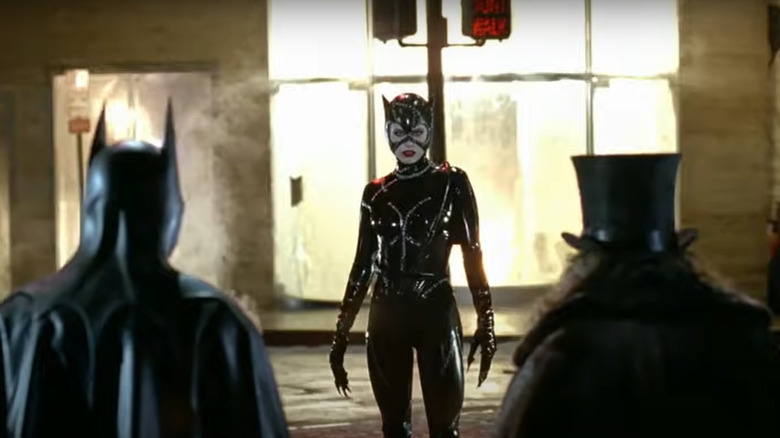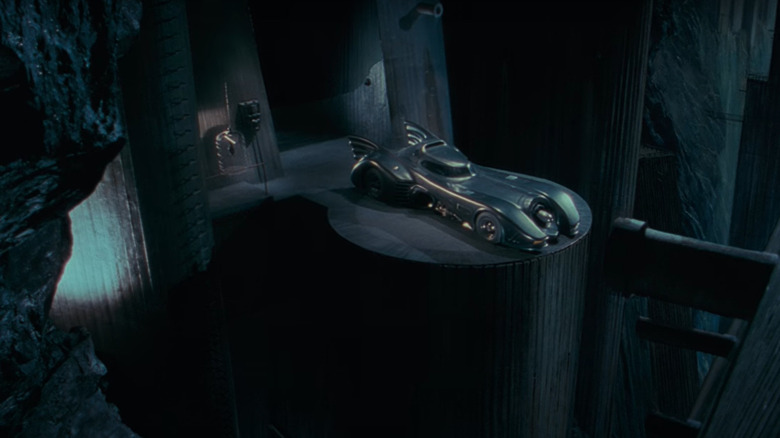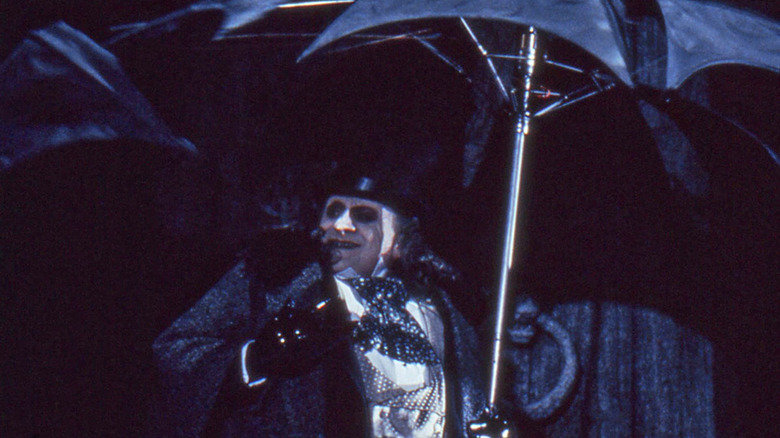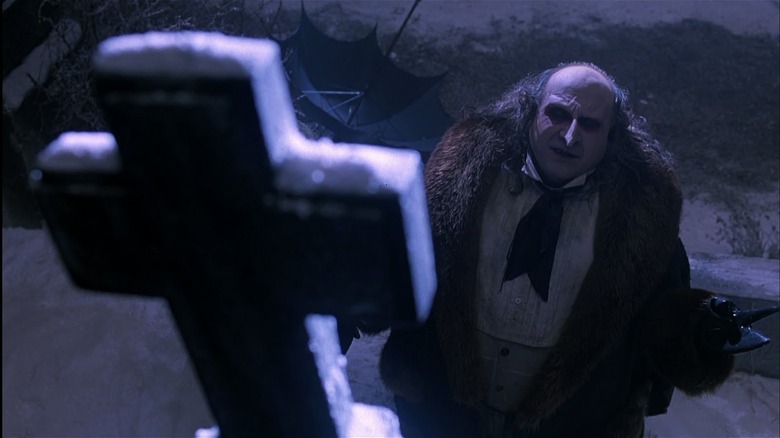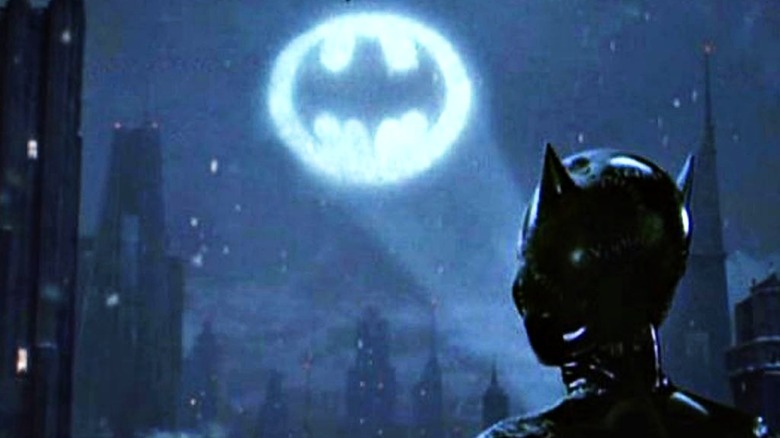The Most Pause-Worthy Moments In Michael Keaton's Batman Movies
Few influential superhero movies had as big an impact on the genre as filmmaker Tim Burton's 1989 classic "Batman," starring Michael Keaton as the Caped Crusader. The movie is generally credited with taking superhero films out of the realm of colorful fantasy as typified by 1978's "Superman" into the gritty real world.
Younger audiences might find it strange to consider Burton's "Batman" movies "gritty" compared to what Christopher Nolan did with the character in the "Dark Knight" trilogy. But the fact is Burton's original "Batman" and it's 1992 follow-up, "Batman Returns," were path-breakingly grounded for their time. Keaton is credited with turning Bruce Wayne/Batman into a serious figure after years of audiences knowing the character best from Adam West's campy "Batman" TV series.
Burton's films also treated its villains as serious, tragic figures instead of over-the-top cartoons. Jack Nicholson's Joker, Danny DeVito's Penguin, and Michelle Pfeiffer's Catwoman are still considered some of the best characters in the history of superhero movies. Let us take a look at some of the iconic moments from "Batman" and "Batman Returns" that have been watched and re-watched endlessly over the years.
Bruce Wayne answers the call to adventure
Before Michael Keaton donned the pointy ears of the Caped Crusader, the public had a fixed idea of what Batman was all about. Bruce Wayne was a debonair playboy industrialist by day, who donned the cape and cowl at night to embark on a series of adventures as Gotham's Dark Knight. Batman was seen as the main draw, and Bruce was just the swanky rich guy he pretended to be in his spare time.
But Keaton understood that it should be the other way around, with Bruce being the real person, and Batman an extension of his tormented psyche. "I always knew from the get-go, it was Bruce Wayne," the actor explained in an interview for the Backstage podcast. "That was the secret ... I never talked about it. [People would say,] 'Batman does this,' and I kept thinking to myself, you know, y'all are thinking wrong here. It's about Bruce Wayne. Who's that guy? What kind of person does that?"
Thus, instead of a careless playboy, Keaton's Bruce Wayne became a serious crusader obsessed with the idea of putting on the mask and protecting Gotham. The best scene encapsulating this idea occurs at the start of "Batman Returns." We see Bruce Wayne sitting alone in the dark in his mansion, friendless and seemingly despondent. But then the Bat-signal shines through the window, and Bruce's entire body language transforms as he springs into action, ready to answer the call.
Batman identifies himself
A big test for a new actor who has taken on the role of Batman in a movie is a tradition in which the Caped Crusader first identifies himself to a villain. Christian Bale did it in "Batman Begins," when he swung Carmine Falcone (Tom Wilkinson) out of his car and growled "I'm Batman" at him. Robert Pattinson does a version of it when he says "I'm vengeance" in the trailer for "The Batman."
This tradition started with Michael Keaton. At the start of 1989's "Batman," a couple of petty thugs terrorize a family and make off with their money. Batman is alerted to the crime and tracks the criminals down to where they sit examining their loot. The dark figure drops silently behind them, then announces his arrival with the flaring of his cape. The criminals try to put up a fight or run away, but they are helpless against the Dark Knight.
When only one thug is left, Batman tells him to go and tell all the other criminals in Gotham what happened that day. The panicked criminal demands, "What are you?" In answer to that his attacker pulls him close while dangling him off the edge of the roof and declares, "I'm Batman." With that one scene, any remaining doubts that this Batman would be anything like the one in Adam West's old show were instantly dispelled.
The Joker revealed
Michael Keaton was a rising star when "Batman" debuted in 1989, but the real draw of the movie was Jack Nicholson, coming off his ninth Academy Award nomination, in the role of Batman's arch-enemy, the Joker. Fans were expecting big things from Nicholson, and he did not disappoint.
In this version of the story, Joker starts out as regular gangster Jack Napier who works for a local crime boss named Grissom. After the two have a falling out, Grissom sends Jack on a mission to retrieve some evidence while secretly setting him up to be killed. The police, Batman, and Jack have a standoff which ends with Jack falling into a vat of toxic chemicals. He survives the incident, but is transformed into a man with chalk-white skin, green hair and a rictus grin. Driven insane by the changes to his body, Jack arrives at the home of his old boss.
Grissom tries to talk his way out of the confrontation by appealing to their friendship. But when he calls Jack by his name, the latter steps out of the shadows to reveal his new look as he declares, "Jack is dead, my friend. You can call me Joker." He proceeds to gun Grissom down while laughing and cavorting gleefully, proving that Nicholson knew just what it meant to embody the Clown Prince of Crime.
The deadly smirk
Movie Batman has always had a contentious relationship with the "no-kill" rule that the Caped Crusader lives by in the comics. Christian Bale's Batman famously had a strict rule about not killing his enemies, no matter how far Heath Ledger's Joker tried to push him. On the other hand, Ben Affleck's Batman is infamous for gunning down criminals without mercy as an older and more cynical Batman.
But the Batman who was the most casual about taking lives was probably Michael Keaton's Batman, as shown in a scene in "Batman Returns" when the Dark Knight is confronted by a much larger opponent. At first Batman tries to use his fists against the giant criminal. But his punches have no effect, and the criminal laughs in his face.
Batman glances down, and the criminal follows his gaze to see the Dark Knight had strapped a bomb to his stomach. As the criminal looks horrified, Batman smirks and tosses him down a hole in the ground where he explodes into smithereens. Take note, criminals. If you ever see Batman smiling at you in the middle of a fight, drop whatever you're doing and run away as fast as you can, because the Dark Knight has a pretty twisted sense of humor.
The Joker's question
1989's "Batman" made a major change to the fictional history of the Caped Crusader. It rearranged the hero's origin story to reveal that it was Joker, in his previous avatar as Jack Napier, who had been responsible for shooting down Bruce Wayne's parents in an alleyway one dark night.
In the movie, before shooting Bruce's parents, Jack asks them a question that he likes to ask all his victims: "Have you ever danced with the devil in the pale moonlight?" He continues to ask this question later as the Joker, claiming he just likes the way it sounds. When Joker poses the same question to an adult Bruce Wayne before preparing to kill him, Bruce realizes Joker is responsible for the greatest tragedy of his life.
Some fans criticized this need to link up Joker and Batman's origins as unnecessary, since it made Bruce's vendetta against the criminal deeply personal rather than a larger part of his crusade to end injustice in Gotham. But the same idea was re-visited in 2019's "Joker," which reveals that it was one of the Clown Prince of Crime's followers who gunned down Thomas and Martha Wayne in a fit of rage against Gotham's elites.
Let's get nuts
When Michael Keaton was first announced to be playing the role of Batman, there was great outrage among fans. Few people thought the slim, frizzy-haired actor best known for comedy roles had what it took to portray the Dark Knight. But Tim Burton stuck to Keaton's casting, believing the actor understood the mental issues that made someone like Bruce Wayne want to become Batman.
Burton's gamble paid off, and Keaton portrayed arguably the most interesting version of Bruce Wayne ever seen. Keaton's Bruce always seems on the edge of madness, while his Batman mask and cape become a way to control and focus that madness into something productive. And there is no better proof of Bruce's inherent craziness than in the scene where he is confronted by Joker.
Showing no hint of fear, Bruce walks right up to Joker talking about his past as Jack Napier before grabbing a fire poker and threatening the villain and his henchmen with it. In that scene, despite wearing an ordinary business suit instead of his Bat costume, Bruce acts insane enough to even give Joker pause. It's the kind of performance you can only buy from Keaton's slightly unhinged version of Bruce Wayne.
The Bat-plane against the moon
The smartest thing Tim Burton did for 1989's "Batman" was filling the cast with genuinely talented actors who were passionate about their roles (and the money). But Burton's own passion was to bring the gothic, comic-book style nature of Gotham City and Batman to life in a cinematic manner.
Thus, Burton's movie is filled with unspoken allusions and visual references to the history of the Caped Crusader. Instead of trying to ground his cinematic world entirely in the real one, like future franchise filmmakers Christopher Nolan and Matt Reeves, Burton's approach was more dramatic and operatic.
Perhaps the best example of this occurs near the end of "Batman," when the titular hero brings out his Bat-plane to hunt down Joker in the streets of Gotham. For a moment, the Dark Knight's plane hangs upright in the night sky, framed perfectly within the edges of the moon to give an impression of the Bat-symbol adorned on Batman's chest. It remains one of the most beautiful shots in the history of live-action "Batman" movies.
Joker's dare
Despite the fact that Batman is a tall, forbidding figure who routinely takes down mobs of criminals without breaking a sweat, his final confrontation with Joker, a middle-aged gangster, feels suitably epic. And that is largely thanks to the level of insanity Jack Nicholson was able to imbue his character with. In Nicholson's hands, Joker was far removed from Cesar Romero's cheerful prankster in the "Batman" TV show. Nicholson's Joker was far more menacing, and much more crazy than anything the audience had seen before.
Case in point: When Batman charges at the Joker with his Bat-plane, Joker does not flinch. Instead, he dares Batman to come at him, and stands unfazed as Batman fires warning shots all around him. Later, this scene would be referenced in 2008's "The Dark Knight," when Heath Ledger's Joker dares Batman to hit him with his bike in a similar manner.
The final confrontation
Jack Napier's gradual descent into madness is a major theme of the 1989 film. Ever since falling into the vat of chemicals, Jack's grip on reality has begun to shake loose, starting with nicknaming himself "Joker" and acting in ways that go against any sane person's instinct for self-preservation.
From trying to take over Gotham single-handedly, to infecting random citizens with a poisonous gas, to standing in the middle of gunfire without turning a hair, Joker's madness slowly starts enveloping his entire mind. By the time of the epic climax, he has become a completely deranged lunatic, and thus even more dangerous, dragging Vicki Vale (Kim Basinger) to the top of a cathedral with Batman in pursuit.
Nicholson lets fully loose in his final scenes in the movie, cackling maniacally as he tries to stamp and break down the ledge to which Batman and Vicki are hanging for dear life. Joker's maddened glee, Batman's sense of urgency as the ledge breaks piece by piece, and the swelling background music make it one of the most epic superhero movie finales ever created. The final shot of Joker lying on the pavement after tumbling to his death, still with a smile stretched across his face, is a truly haunting moment.
Catwoman announces her presence
The only issue with 1989's "Batman" is that it put a definitive end to that franchise's version of the Joker. With the Dark Knight's greatest enemy already dead, fans wondered how the sequel could possibly manage to top the chaos created in the original film. Tim Burton's answer was to have three main villains in 1992's "Batman Returns" in place of one.
Christopher Walken starred as Max Shreck, a corrupt industrialist who does not mind doing anything to (or with) anyone to get his own way. Max's habits bring him into collaboration with the villainous Oswald Cobblepot, aka Penguin (Danny DeVito). Max is also responsible for the transformation of Selina Kyle (Michelle Pfeiffer) from an ordinary secretary into the anti-heroine Catwoman.
Kyle's introduction as Catwoman is a sight to behold. The Dark Knight is having a tense discussion with Penguin when they spy a black-clad figure somersaulting away from a jewelry store. The figure lands upright, and Catwoman greets the other two with a "Meow," just as the jewelry store behind her explodes. It's as fiery an entrance as you can hope to have.
The cave and the car
Before Tim Burton came along, Batman's live-action secret cave where he monitored Gotham's safety was simply depicted as yet another brightly lit room with advanced gadgets and a giant "Bat-computer" for all of the Caped Crusader's crime-solving needs. But in the hands of Burton, the "Cave" part of the Batcave took on a new significance.
The new Batcave was an actual giant subterranean space that would be frankly impossible to build in secret. Fortunately, Burton did not worry about the real-world logistics, and focused on making the cave as awesomely gothic and dark as possible. The entire space has a strong black theme, and is generally depicted as an extension of Bruce Wayne's troubled psyche.
The cherry on top is the Batmobile, the vehicle Batman uses to get around his city. Unlike previous versions of the vehicle that look like regular cars with the Bat-logo slapped on, Burton's Batmobile almost looks like an alien thing, an unholy meeting point between a racing car and a rocket-powered tank with a preposterous number of inbuilt gadgets like Gatling guns and a full-body protective cocoon shell.
The penguin flies away
Possibly the biggest gamble Tim Burton took with "Batman Returns" was casting the Penguin as a major villain. Penguin had always been a somewhat comical character, both in his appearance and his behavior, a perception which, on the surface, appeared to clash with Burton's determination to make serious movies about the Dark Knight. Danny DeVito is also known primarily as a comic actor, and did not seem to present much of a physical threat to a guy like Batman.
But Burton and DeVito knew what they were doing. Their take on Oswald Cobblepot was not comical, but a tragic and menacing figure who could actually stand up to Batman and terrorize the whole of Gotham. Burton even managed to make the more ridiculous aspects of Penguin's backstory work, like his flying umbrella. In the movie, the umbrella is reimagined as a disguised helicopter that the Penguin memorably uses to fly away to safety, or even to choke Catwoman to death when he attaches his umbrella around her neck like a noose and sends her flying.
Penguin visits his parents
In the comics, Penguin is a regular mob boss with delusions of grandeur who desires to see himself among Gotham's elites. Tim Burton reimagined the character with a more tragic background. This version of Oswald Cobblepot was abandoned by his parents as a baby based on his physical deformities.
One of the most touching scenes in "Batman Returns" is when Burton is allowed to give free rein to his tragically gothic sensibilities. Oswald visits the snow-covered graveyard where his parents' graves are located. The short, round figure does not look villainous in that moment, but like someone you might actually feel sorry for as he mourns the loss of parents who never wanted him.
The scene does much to humanize a bizarre character like the Penguin, and DeVito really sells the emotions in the scene to the point where you begin to sympathize with Oswald. The actor's memorable performance had fans clamoring for more, and DeVito himself is willing to reprise the character if the original filmmaker is game. "This is all up to Tim, whether or not Tim wants to do this," DeVito explained to Forbes in 2021. "I would say that could be in the cards because we ain't dead yet."
Catwoman survives
While everyone brought their A-game to "Batman Returns," the breakout favorite was Michelle Pfeiffer as Catwoman. The character's story was drastically changed from the comics. Instead of being a thief from an early age, Selina was depicted as a mousy secretary who becomes the demented Catwoman after a near-death experience.
Selina gets the most compelling personal story arc in the movie. She goes from being a repressed person to glorying in the freedom from rules that being Catwoman affords her. She then gets tangled up in the war between Batman and Penguin while seeking revenge against her former boss, Max Shreck, for almost killing her. It all culminates in the dramatic finale where Max shoots Catwoman dead while also dying in the process. For a while, it seems Catwoman is gone for good.
But the final scene in the movie shows the character's profile from behind, watching the Bat-signal in the sky, indicating that the Cat will continue to cause trouble for Batman and Gotham. It's the kind of ending that today would have been a mid-credits scene setting up a spinoff "Catwoman" movie. Unfortunately, the next "Batman" film saw a changing of the guard, including the director and lead actor, and we never did get to see what happened to Pfeiffer's Catwoman after that.
